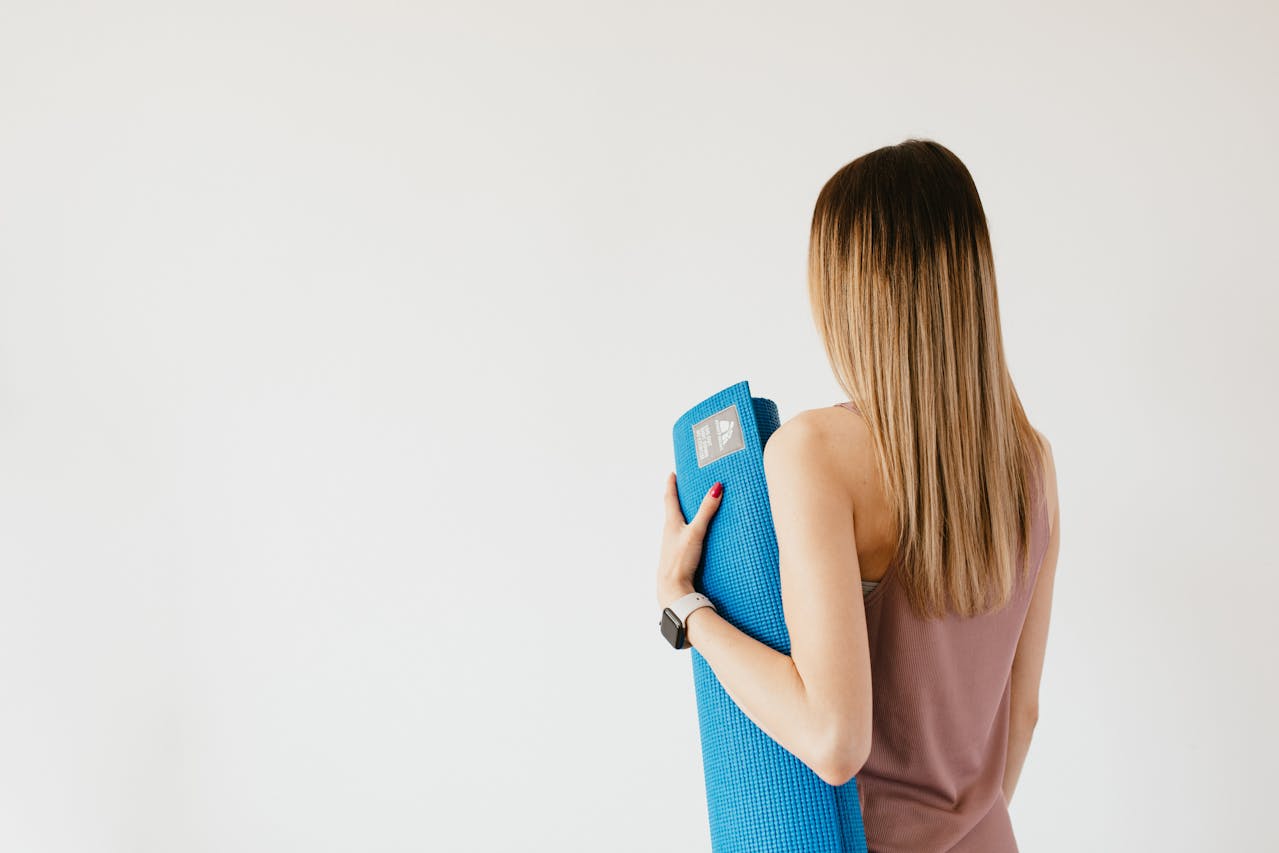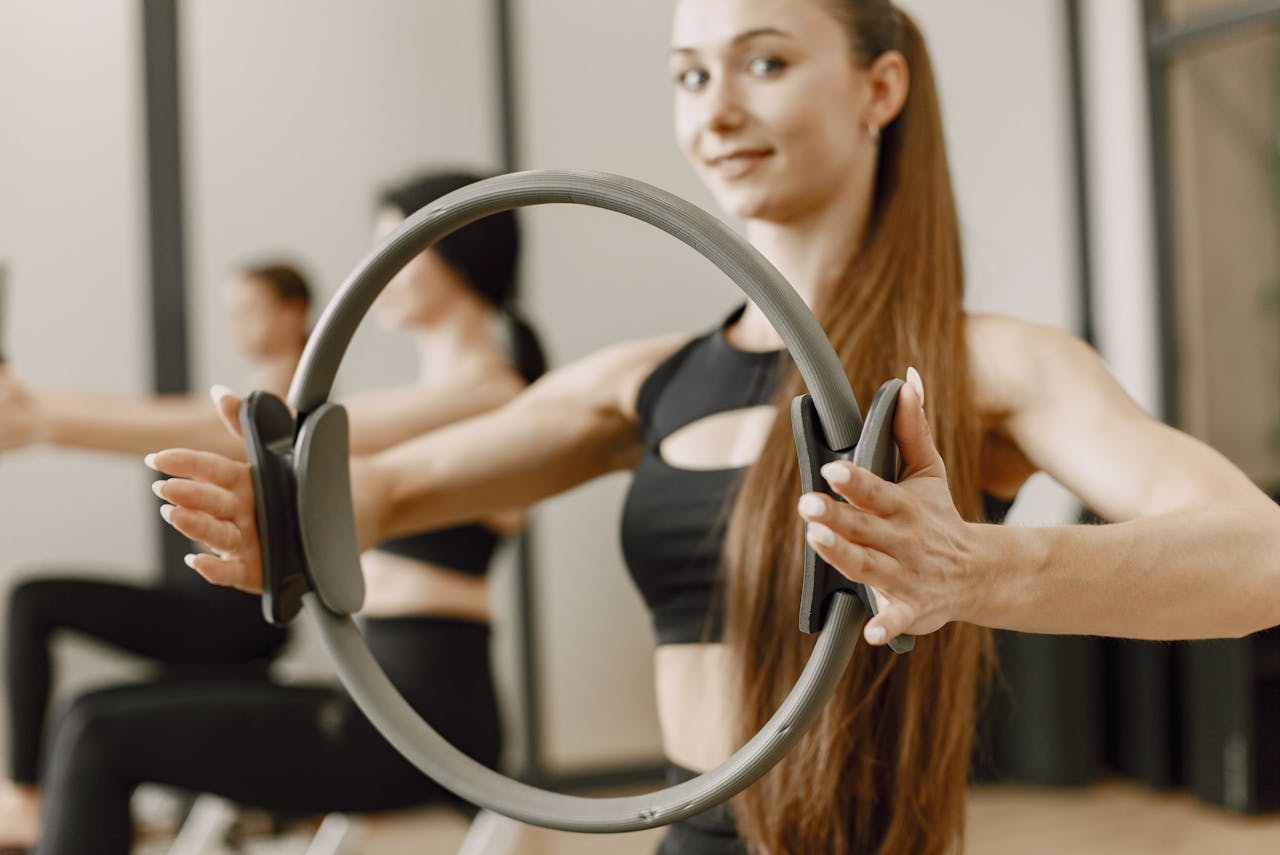When you’re looking to elevate your Pilates workouts, incorporating crucial props can make a notable difference.
From the foundational Pilates mat to unique tools like the Magic Circle and Pilates Arc, each prop serves a distinct purpose in enhancing your practice. Imagine how resistance bands can add a new layer of strength training or how a stability ball can challenge your balance and core stability.
But that’s just scratching the surface. What specific benefits do these props offer, and how can they transform your routine?
Let’s examine each one to uncover their full potential.
Pilates Mat
When starting your Pilates adventure, a high-quality Pilates mat is essential for comfort and support. You’ll want a mat that’s thicker than a standard yoga mat, typically around half an inch, to cushion your spine, hips, and knees during different exercises. Choose non-slip surfaces to prevent any unexpected movement, ensuring stability throughout your practice.
Look for mats made from durable materials like PVC or TPE, as these can withstand frequent use and are easy to clean. Take size into account as well; a longer and wider mat provides ample space to perform a full range of movements without restriction. Investing in a good Pilates mat enhances your workout experience, allowing you to focus on technique and alignment without discomfort.

Resistance Bands
Resistance bands are a flexible addition to your Pilates routine, offering adjustable resistance to challenge and enhance your strength training. These bands come in different levels, from light to heavy, allowing you to customize your workout intensity. They’re perfect for targeting specific muscle groups, improving flexibility, and increasing total strength.
To incorporate resistance bands into your practice, start with basic exercises like leg presses or arm curls. Make sure you maintain proper form, keeping tension in the band throughout the movement. This helps activate stabilizing muscles, providing a more thorough workout. Resistance bands are also portable, making them ideal for at-home workouts or travel. Remember to choose bands that match your fitness level to avoid strain or injury.
Pilates Ring
The Pilates ring, also known as the magic circle, is a versatile tool that adds an extra layer of resistance and challenge to your Pilates workouts. It’s commonly used to target specific muscle groups, enhancing your strength, flexibility, and endurance. By incorporating the ring into exercises like leg squeezes, arm presses, and core work, you engage multiple muscles simultaneously, promoting balanced muscle development.
Hold the ring between your hands or place it between your knees to create resistance, ensuring your movements remain controlled and precise. It’s lightweight and portable, making it easy to incorporate into your home practice or take to the studio. Regular use of the Pilates ring can notably improve your comprehensive muscle tone and posture.

Pilates Arc
When you’re looking to enhance your Pilates practice, the Pilates Arc offers dynamic support and challenge for multiple exercises. This versatile prop’s unique curved shape helps you deepen stretches, refine alignment, and build core strength. You’ll find it particularly useful for exercises targeting the spine, as it promotes proper posture and spinal articulation.
To use the Pilates Arc effectively, start by incorporating it into your core and back exercises. Place it under your lower back during abdominal curls to increase the range of motion. For spinal extensions, lie face down with the Arc supporting your chest. Always make sure you’re maintaining control and alignment, using your breath to guide each movement. With consistent practice, the Pilates Arc can greatly elevate your workouts.
Foam Roller
Incorporating a foam roller into your Pilates routine can help release muscle tension and improve flexibility. This versatile prop allows you to perform self-myofascial release, targeting tight spots in your muscles. To use it, position the roller under the area you want to massage and gently roll back and forth. You’ll find it particularly useful for alleviating tightness in your back, calves, and thighs.
Furthermore, foam rollers can be used for balance exercises, enhancing your core stability. When selecting a foam roller, take into account its density; firmer rollers provide a deeper massage, while softer ones offer a gentler touch. Start with a medium-density roller if you’re new to this practice, and gradually adapt to your comfort level.

Yoga Block
You’ll find a yoga block to be an invaluable tool for enhancing your Pilates practice by providing support and stability. These blocks can help you achieve proper alignment, especially in challenging poses. Use them to modify exercises, making movements more accessible if you’re not as flexible or if you’re recovering from an injury. Place the block under your hands, feet, or seat to deepen stretches and maintain balance.
When performing seated exercises, a block can elevate your hips, helping to keep your spine straight. Choose a firm, durable block that can withstand consistent use. Incorporate the block into your routines regularly, and you’ll notice improvements in your strength, flexibility, and general form over time.
Ankle Weights
Adding ankle weights to your Pilates routine can intensify your workouts, helping to build strength and endurance. By increasing resistance, ankle weights make your muscles work harder, promoting muscle growth and toning. Start with light weights to avoid strain, gradually increasing as your strength improves.
Use them during leg lifts, bridges, or even while performing core exercises to target different muscle groups. Confirm the weights fit snugly around your ankles without restricting movement. Focus on maintaining proper form, as improper use can lead to injury. Incorporating ankle weights can enhance your Pilates practice, providing a new challenge and aiding in achieving your fitness goals more efficiently. Remember, consistency and correct usage are key for best results.

Magic Circle
The Magic Circle, also known as a Pilates ring, is a versatile tool that can add resistance and challenge to your Pilates exercises. It’s lightweight and portable, making it easy to incorporate into your routine whether you’re at home or in a studio.
You can use the Magic Circle to engage your inner and outer thighs, arms, chest, and core. When squeezing the ring between your hands or thighs, you’ll activate muscles that might otherwise be neglected.
This can enhance your strength, stability, and alignment. To start, try placing it between your ankles during leg lifts or between your palms during chest presses. These exercises can help you improve muscle tone and total body control.
Stability Ball
A stability ball can significantly enhance your Pilates practice by challenging your balance and engaging your core muscles. When you incorporate a stability ball into exercises like planks, crunches, or bridges, you force your body to stabilize, which activates deeper muscles.
Start with basic exercises, and gradually introduce more complex movements as you gain confidence. Make sure the ball is properly inflated; it should be firm yet slightly yielding. Choose the right size ball for your height—your knees should be at a 90-degree angle when you sit on it. Maintaining proper form is essential, so use a mirror or work with an instructor if possible. Integrating a stability ball can add variety and intensity, enhancing your overall Pilates experience.

Balance Board
Incorporating a balance board into your Pilates routine can substantially enhance your stability and core strength. By challenging your balance, this prop engages deep, stabilizing muscles that are often overlooked. Start by standing on the board with feet hip-width apart, maintaining a neutral spine, and engaging your core. Small, controlled movements help improve proprioception, enhancing your complete body awareness.
You can also perform seated exercises, like seated leg lifts, to target your lower body. For increased intensity, try plank variations on the balance board, which demand greater core activation. Always make sure you’re working on a non-slip surface to prevent accidents. Integrating the balance board into your practice will help you build a stronger, more balanced physique.
Conclusion
Incorporating these vital Pilates props into your practice can notably enhance your workouts.
A comfortable mat, resistance bands, and a Pilates ring will help you build strength and engage muscles effectively. Stability balls and foam rollers improve balance and aid recovery, while yoga blocks and ankle weights provide stability and intensity. The Magic Circle, Pilates Arc, and balance board promote better alignment and core strength.
Together, these tools create an all-encompassing, effective Pilates experience.

